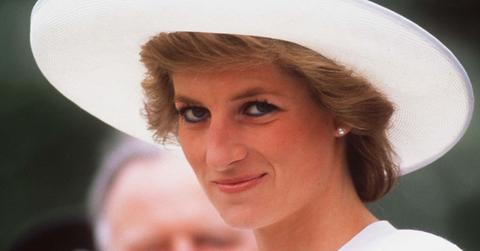 NEWS
NEWS‘Diana: Case Solved’: Princess Diana ‘Was A Threat To The Establishment,’ But Did That Cause Her Death? (Exclusive Excerpt)

Sept. 19 2019, Updated 4:06 p.m. ET
There are sensational new calls for a new inquiry into Princess Diana‘s tragic death after explosive new details and evidence have emerged about what really happened 22 years ago in Paris.
A new book, published Tuesday, identifies the mystery man driving a white Fiat Uno that investigators believed clipped Diana’s car leading her to careen into the Pont de l’Alma tunnel in 1997.
In Diana: Case Solved by journalist Dylan Howard and former homicide cop Colin McLaren, out now via Skyhorse Publishing and Start Publishing, the co-authors discuss the wild conspiracy theories that have mired the case for decades.

Below is an exclusive excerpt from chapter thirteen of Diana: Case Solved, available only on Amazon.
To get the definitive account that proves what really happened to Diana, order the book here.
They were everywhere.
From scorned ex-lovers to angered international arms dealers, Diana had an enemies list like few have ever seen—a list much longer than Colin and I, as investigators, put together. Between her own countless premonitions of death to the outright threats against her, it is a wonder she lived so long. Nations, international conglomerates, and the British royal family all stood to benefit from her shutting up and going away forever—and such a thing can be accomplished a number of ways. Yet foremost among them, and certainly foremost in effectiveness, would be snuffing out Diana’s life entirely.
Diana was a threat to the establishment for a host of reasons. For the royals, it was a reputation cost. Diana threatened to cheapen the monarchy; to blur the line between acceptable and unacceptable behavior for a member of the family. And most unnerving of all, she threatened to dispel the magic that made outsiders feel as though the royals were exceptional and special. If that were to occur, many in the public might start asking questions about why the royals are followed, tolerated, and subsidized in the first place. Everything the family had built could all come crashing down.
And the powerful international entities Diana threatened saw her as a risk to their very chummy way of doing business. To their racket. Land mines alone were probably enough to get Diana on their watch list.
Consider the following: In Country A (as in the United States), there is a large military defense contractor that makes land mines. In every election cycle, lobbyists in the employ of this defense contractor make heavy campaign donations to politicians who support foreign aid to war-torn Country B. Once elected, these politicians green-light several billions of dollars in aid from Country A to Country B. But there is a tacit understanding. Country B knows that it must use the preponderance of the funds received to arm itself against future oppression. . . by purchasing arms from the defense contractor in Country A. It is a racket in which everybody wins.
The defense contractor turns a few million in lobbying funds into a few billion in land mine sales. The politicians get their election coffers filled and stay in power. And the war-torn country gets a whole bunch of money for arms (with a bit left over to grease the political wheels on their end, too). It was a nice, “legal” scheme for making money and solidifying power . . . and one idealistic royal threatened to send it all crashing to the ground.
Again, the wonder is not that Diana was killed—and she was killed—but that her life was not taken sooner.
One imagines that initially, the players involved must have looked to one another. Can’t the royal family handle it? Can’t the British government make her shut up and stop speaking out like this? But they could not, and they did not. Diana persisted.
But she wasn’t killed as a result of an orchestrated execution.
It was an all-too-familiar road accident.
Here is how.
***
Our new research has shown that the paparazzi were not to blame in Diana’s death, and that it was instead a case of someone being in the wrong place at the wrong time.
Painstaking decades of work, in-person interviews with witnesses and those involved, as well as multiple visits to the crime scene have brought forth revelations that French and/or British police either did not see, or were not in a position, politically, to acknowledge.
We have found that on the night of her death, the $123,000 Mercedes that carried Diana and others was capable of easily out-accelerating every single vehicle that the members of the paparazzi were driving. In short, there was no neck-and-neck chase, as such a thing was an impossibility. The mass of photographers could not have kept up with her car. Period.
Yet as her car neared the tunnel on that fateful night, there were numerous witnesses—many, only auditory—who heard a loud screeching of tires. This could only have been the Mercedes braking suddenly. Why? Had driver Henri Paul simply failed to notice the tunnel that was right in front of him? Even in a somewhat intoxicated state, this seems unlikely.
But something made him brake.
Other witnesses claim to have seen a flash in the tunnel—or in the moments before the car entered the tunnel—just before Diana’s death. It would seem easy— perhaps too easy—to conclude that this flash was from a photographer’s camera.
But when we stop and think, we have to ask how this could possibly be. Diana’s Mercedes was too fast. The paparazzi could not catch up with it. They arrived after the fact, of course, to take photos of the death car.
Want OK! each day? Sign up here!
But none were present when the vehicle literally met its doom.
We can now, in this book, reveal that additional research into the circumstances of Diana’s death brought forth two new witnesses—George and Sabine Dauzonne—who were present at the accident and confirmed details to Colin of a particular scenario that has long been floated but never proven . . . until now.
While the motorcycle make and models driven by the photographers were not able to keep up with Diana’s car that night, two other vehicles were. These vehicles were in close proximity to Diana’s car as it approached the tunnel. The vehicles were a motorcycle and a white Fiat Uno that had joined the road late in the game.
The motorcyclist remains a mystery, but the Dauzonnes got a clear look at the driver of the Uno, as Colin discovered.
In the aftermath of the accident, a fragment of plastic was found by French police. It came from a Fiat Uno. In addition, Diana’s Mercedes was found to have a smear of white paint upon it. This paint was analyzed, and found to be paint that was only used by one manufacturer: Fiat. An exhaustive database search of over 112,00 Fiats never found the elusive car. Despite calls to the public, no person ever came forward as the driver.
In the days after Diana’s death, during the inquest into what precisely had happened, no less an authority than Sir Richard Dearlove, former head of MI6, poured fuel on the fire that the “flash of light tunnel murder” scenario was not only an established assassination format, but one that the British government itself had considered using in the past.
Specifically, Dearlove outlined a scenario that the British government had contemplated deploying in the early 1990s to assassinate a senior Balkan politician by forcing a crash. When the politician’s car passed into a tunnel, a blinding flash device would have been deployed, bright enough to blind and disorient the driver. (In a world in which the CIA has openly confirmed possessing “heart attack guns” for decades, it requires no leap of faith to trust that a blinding device such as this existed in 1997.) The flash would be mistaken by any bystanders as a photograph, but the effects would be deadly. The driver of the car would lose control of the vehicle and crash into the tunnel in such a way that the death of the target would be essentially assured.
A year after Dearlove’s testimony, Richard Tomlinson, a former British spy, also publicly confirmed and corroborated Dearlove’s account.
What seems possible is that the mysterious lone motorcyclist deployed this blinding device while Diana’s car was in the tunnel. In her memoir Spies, Lies and Whistleblowers, former MI5 agent Annie Machon confirms her belief that this is precisely what happened.
What was the Fiat Uno’s role? Did it somehow assist in the deployment of the device? Did the driver steer his car in such a way so to help the motorcyclist in deploying it? Or was he or she merely an Oswald-like patsy? Was the car only there to soak up blame and attention in the aftermath, to distract investigators from the real clues? Or was it, as we believe, a simple and routine car accident? We would know the answers to many of these queries if we had, for example, footage of the accident.
There were two CCTV cameras in the Pont de l’Alma underpass, but neither recorded footage of the fatal collision. They were either malfunctioning on the night in question, or not positioned to shoot the correct part of the tunnel. This too unbelievable to be dismissed as a coincidence.
Indeed, a French judicial inquiry into the crash was told that neither camera was working on the night in question. Both, unbelievably, were broken. However, one motorist who came forward to the press shared that he received a speeding ticket after being caught on a tunnel camera just fifteen minutes prior to the accident.
But a lack of cameras was not enough. The flash-attack itself was not enough. The conspirators had to do more.
French security services who were part of the cover-up leaked information to the press that Henri Paul was a drunk, and was three-and-a-half times over the legal limit on the night of the crash. They also switched his blood sample at the lab, replacing his with that of an alcoholic. This was all but proved when Paul’s physician confirmed which medications Paul was taking, and that those drugs did not show up in his system.
If you believe some armchair detectives, however, Henri Paul was sober as a judge when he was attacked and disoriented with a top-secret government light device that likely rendered him more severely disoriented than any amount of drinks could do.
It all comes back to Diana’s own words in the death note:
“This particular phase in my life is the most dangerous. My husband is planning “an accident” in my car, brake failure and serious head injury in order to make the path clear for him to marry.”
In October 1995, the princess told Lord Mishcon, her solicitor, that “reliable sources” had informed her of the prince’s plans “that she and Camilla would be put aside.” We find this document today in the National Archive in London.
If the disbelievers are to be believed, Diana was murdered, and she was murdered by forces with leading-edge spy technology, and with the power to create international complicity between governments and government agencies. She was just that dangerous, and just that powerful. Because of her behavior, she had to be stopped. This story could have ended no other way.
Yet our story continues, with a unique and unprecedented encounter with one of the chief players. And what it reveals shines an entirely new light on what happened.
Armed with this information, we knew what we had to do.
For more, order Diana: Case Solved here.


